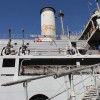Camp Katrina helped workers get through storm’s aftermath
WHEN HURRICANE KATRINA ravaged the Gulf Coast in 2005, much of the New Orleans population scattered to other parts of the country, or at least fled to higher ground deeper inland. The situation created a dilemma for Northrop Grumman Shipbuilding (NGSB), which needed to keep its skilled work force intact to fill U.S. Navy contracts at the Avondale shipyard. One of those contracts was for LPD 21, the New York, which was under construction at the yard when Katrina struck.
Shipyard workers, including many from Local 1814 (Bridge City, La.) faced their own dilemma. Many had lost their homes and vehicles or found their homes uninhabitable until floodwaters receded and repairs could be made. They needed paychecks more than ever.
To address the situation, NGSB came up with a plan to convert the yard’s training center into a makeshift barracks. “Camp Katrina,” as the barracks was dubbed, would give workers a place to stay — and work — while the region began the long, painful process of recovery.
“It was a blessing,” said Ricky Washington, 47, a ship fitter for 27 years. “You had three square meals a day, a bunk, and a locker. It was kind of like being in the military.”
The camp gave Washington and others an opportunity to start getting their lives back together. Open for about two years, it accommodated hundreds of dislocated workers. Many of them lived at Camp Katrina during the week, then on weekends drove to Baton Rouge or other inland communities to be with their families, who no longer had a place to live in New Orleans.
Harold Brown, 63, a ship fitter with seven years at the yard, lived in hard-hit St. Bernard Parish. He lived at Camp Katrina for three months until the Federal Emergency Management Administration (FEMA) provided him with a trailer.
Others, like Jorge Martinez, 54, a welder with 30 years experience at Avondale, lived at the shipyard while gradually making repairs to their homes. “I had to fight with the insurance company,” he said. “I lost my truck.”
Many L-1814 members live with the harrowing memory of being trapped for days before help could reach them, followed by temporary relocations to Houston, Dallas, and other cities.
For those who took advantage of it, Camp Katrina was a lifeline. However, many L-1814 members never came back to New Orleans. Said Chris Burnett, L-1814’s president, “We had some guys, after their wives had got their kids in other schools, who said, ‘I’m not moving back there.’ A lot of people had lost so much that was sentimental — photos and other items. They don’t want to experience that again.”






